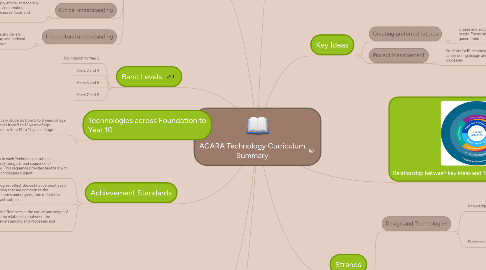
1. Seven General Capabilities
1.1. Literacy
1.1.1. In Technologies, students develop literacy as they learn how to communicate ideas, concepts and detailed proposals to a variety of audiences
1.2. Numeracy
1.2.1. The Technologies curriculum gives students opportunities to interpret and use mathematical knowledge and skills in a range of real-life situations
1.3. ICT
1.3.1. All learning areas provide the content and contexts within which students develop and apply the knowledge, skills, behaviours and dispositions that comprise ICT capability. However it is more explicit and foregrounded in the Digital Technologies subject.
1.4. Critical and creative thinking
1.4.1. Across the Australian Curriculum, students develop capability in critical and creative thinking as they learn to generate and evaluate knowledge, clarify concepts and ideas, seek possibilities, consider alternatives and solve problems
1.5. Personal and social capability
1.5.1. Across the Australian Curriculum, students develop personal and social capability as they learn to understand themselves and others, and manage their RELATIONSHIPS, lives, work and learning more effectively. The capability involves students in a range of practices including recognising and regulating emotions, developing empathy for others and understanding relationships, establishing and building positive relationships, making responsible decisions, working effectively in teams, handling challenging situations constructively and developing leadership skills.
1.6. Ethical understanding
1.6.1. Students develop the capacity to understand and apply ethical and socially responsible principles when collaborating with others and creating, sharing and using technologies –materials, DATA, processes, tools and equipment.
1.7. Intercultural understanding
1.7.1. Across the Australian Curriculum, students develop intercultural understanding as they learn to value their own cultures, languages and beliefs, and those of others. They come to understand how personal, group and national identities are shaped, and the variable and changing nature of culture.
2. Student Diversity:
2.1. Student disability
2.1.1. Many students with disability are able to achieve educational standards commensurate with their peers, as long as the necessary adjustments are made to the way in which they are taught and to the means through which they demonstrate their learning.
2.2. EALD
2.2.1. Technologies are the same for all students, EAL/D students must achieve these aims while simultaneously learning a new language and learning content and skills through that new language. These students may require additional time and support, along with teaching that explicitly addresses their language needs.
2.3. Gifted and talented students
2.3.1. Teachers can enrich student learning by providing students with opportunities to work with learning area content in more depth or breadth; emphasising specific aspects of the general capabilities learning continua (for example, the higher-order cognitive skills of the Critical and creative thinking capability); and/or focusing on cross-curriculum priorities.
3. Cross Curricular Priorities
3.1. Aboriginal and Torres Strait Islander histories and cultures
3.2. Asia and Australia’s engagement with Asia
3.3. Sustainability
4. Technologies across Foundation to Year 10
4.1. Foundation – Year 2: typically students from 5 to 8 years of age Year 3 – 6: typically students from 8 to 12 years of age Year 7 – 10: typically students from 12 to 16 years of age.
5. Achievement Standards
5.1. The sequence of achievement standards in each Technologies subject describes progress in the subject, demonstrating a broad sequence of expected learning by the end of the band. This sequence provides teachers with a framework for development in each Technologies subject.
5.2. The achievement standards for Technologies reflect the distinctive practices of each subject along with aspects of learning that are common to the Technologies subjects. Subject-specific terms and organisation reflect the essential characteristics of learning in each subject.
5.3. The achievement standards also reflect differences in the nature and scope of the learning in each subject, as well as the relationship between the interrelated strands: Knowledge and understanding and Processes and production skills.
6. Band Levels
6.1. Foundation to Year 2
6.2. Years 3 and 4
6.3. Years 5 and 6
6.4. Years 7 and 8
7. Aims
7.1. investigate, design, plan, manage, create and evaluate solutions
7.2. are creative, innovative and enterprising when using traditional, contemporary and emerging technologies, and understand how technologies have developed over time
7.3. make informed and ethical decisions about the role, impact and use of technologies in the economy, environment and society for a sustainable future
7.4. engage confidently with and responsibly select and manipulate appropriate technologies − materials, DATA, systems, components, tools and equipment − when designing and creating solutions
7.5. critique, analyse and evaluate problems, needs or opportunities to identify and create solutions.
7.6. These aims are extended and complemented by specific aims for each Technologies subject.
8. Strands
8.1. Design and Technologies
8.1.1. Knowledge and Understanding
8.1.1.1. Technologies and society the use, development and impact of technologies in people’s lives Technologies contexts technologies and design across a range of technologies contexts
8.1.2. Processes and production skills
8.1.2.1. Creating designed solutions by: investigating generating producing evaluating collaborating and managing
8.2. Digital Technology
8.2.1. Knowledge and Understanding
8.2.1.1. Digital systems the components of digital systems: hardware, software and networks and their use Representation of DATA how DATA are represented and structured symbolically
8.2.2. Processes and production skills
8.2.2.1. Collecting, managing and analysing data Creating digital solutions by: defining designing implementing evaluating collaborating and managing
9. Relationship between key ideas and Technologies subjects
10. Key Ideas
10.1. Creating preferred futures
10.1.1. Create and actively design solutions to present needs. Focus on not comprising future generations
10.2. Project Management
10.2.1. Students "self" responsibility for health and safety during design and technology processes
